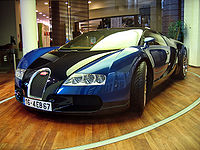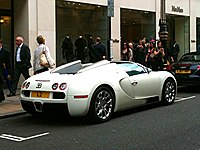Bugatti Veyron theme by xXBulletMagnetXx
Download: BugattiVeyron.p3t
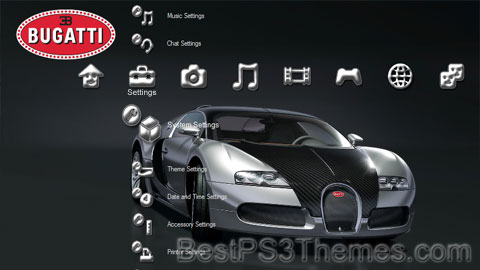
(6 backgrounds)
| Bugatti Veyron 16.4 | |
|---|---|
 | |
| Overview | |
| Manufacturer | Bugatti Automobiles S.A.S. |
| Production |
|
| Assembly | France: Alsace, Molsheim[1] |
| Designer | Jozef Kabaň[2] |
| Body and chassis | |
| Class | Sports car (S) |
| Body style | |
| Layout | Mid-engine, all-wheel drive |
| Related |
|
| Powertrain | |
| Engine | 8.0 L (488 cu in) quad-turbocharged Volkswagen WR16 |
| Power output | |
| Transmission | 7-speed Ricardo dual-clutch automatic |
| Dimensions | |
| Wheelbase | 2,710 mm (106.7 in) |
| Length | 4,462 mm (175.7 in) |
| Width | 1,998 mm (78.7 in) |
| Height | 1,204 mm (47.4 in) |
| Kerb weight | 1,838–1,990 kg (4,052–4,387 lb) |
| Chronology | |
| Predecessor | Bugatti EB 110 |
| Successor | Bugatti Chiron |
The Bugatti Veyron EB 16.4 is a mid-engine sports car, designed and developed in Germany by the Volkswagen Group and Bugatti and manufactured in Molsheim, France, by French automobile manufacturer Bugatti. It was named after the racing driver Pierre Veyron.
The original version has a top speed of 407 km/h (253 mph).[5][6] It was named the 2000s Car of the Decade by the BBC television programme Top Gear. The standard Veyron also won Top Gear's Best Car Driven All Year award in 2005.
The Super Sport version of the Veyron is one of the fastest street-legal production cars in the world, with a top speed of 431.072 km/h (267.856 mph).[7] The Veyron Grand Sport Vitesse was the fastest roadster in the world, reaching an averaged top speed of 408.84 km/h (254.04 mph) in a test on 6 April 2013.[8][9]
The Veyron's chief designer was Hartmut Warkuß, with the exterior being designed by Jozef Kabaň of Volkswagen. Much of the engineering work was conducted under the guidance of chief technical officer Wolfgang Schreiber. The Veyron includes a sound system designed and built by Burmester Audiosysteme.[10]
Several special variants have been produced. In December 2010, Bugatti began offering prospective buyers the ability to customise exterior and interior colours by using the Veyron 16.4 Configurator application on the marque's official website.[11][12] The Bugatti Veyron was discontinued in late 2014, but special edition models continued to be produced until 2015.
Origins[edit]
In May 1998, Volkswagen AG acquired the rights to use the Bugatti logo and the trade name Bugatti Automobiles S.A.S. To succeed the EB 110 model produced under the previous ownership, the automaker quickly released a series of concept cars whose technological advancements would culminate in the form of the Veyron 16.4.
Between October 1998 and September 1999, Bugatti introduced a series of Giugiaro-designed concept vehicles, each with permanent four-wheel drive and powered by the Volkswagen-designed W18 engine. The first car, the EB 118, was a 2-door luxury coupé presented at the 1998 Paris Motor Show. The next car, the EB 218, was a 4-door saloon presented at the 1999 Geneva Motor Show. The third and final car, the 18/3 Chiron, was a mid-engine sports car presented at the 1999 International Motor Show in Frankfurt.[13]
In October 1999, Bugatti unveiled a fourth concept car at the Tokyo Motor Show. The EB 18/4 Veyron was a mid-engine sports car styled in-house under the direction of Hartmut Warkuß.[14] In 2000, a modified version, the EB 16/4 Veyron, was displayed at motor shows in Detroit, Geneva, and Paris. Rather than the three-bank W18 engine of the four previous concept cars, the EB 16/4 featured the four-bank WR16 engine architecture installed in every production example of the Veyron.[15] Warkuß also commissioned SEAT head of design, Walter de Silva, to submit a design proposal for the new Bugatti. The design was ultimately rejected in favour of Warkuß's own proposal.[16]
The decision to start production of the car was made by the Volkswagen Group in 2001. The first roadworthy prototype was completed in August 2003. It is identical to the later series variant, except for a few details. In the transition from development to series production, considerable technical problems had to be addressed, repeatedly delaying production until September 2005.[17]
The Veyron EB 16.4 is named in honor of Pierre Veyron, a Bugatti development engineer, test driver and company race driver who, with co-driver Jean-Pierre Wimille, won the 1939 24 Hours of Le Mans while driving a Bugatti.[18] The "EB" refers to Bugatti founder Ettore Bugatti and the "16.4" refers to the engine's 16 cylinders and quad-turbochargers.[19]
Bugatti Veyron (2005–2011)[edit]
Specifications and performance[edit]

The Veyron features an 8.0-litre, quad-turbocharged, W16 cylinder engine, equivalent to two narrow-angle V8 engines bolted together. Each cylinder has four valves for a total of 64, but the configuration of each bank allows two overhead camshafts to drive two banks of cylinders so only four camshafts are needed. The engine is fed by four turbochargers and displaces 7,993 cc (487.8 cu in), with a square 86 by 86 mm (3.39 by 3.39 in) bore and stroke.


The transmission is a dual-clutch direct-shift computer-controlled automatic transmission having seven gear ratios, with magnesium paddles behind the steering wheel and a shift time of less than 150 milliseconds, built by Ricardo of England rather than Borg-Warner, who designed the six speed DSG used in the mainstream Volkswagen Group marques. The Veyron can be driven in either semi-automatic or fully-automatic mode. A replacement transmission for the Veyron costs just over US$120,000.[20] It also has permanent all-wheel drive using the Haldex Traction system. It uses special Michelin PAX run-flat tyres, designed specifically to accommodate the Veyron's top speed, and cost US$25,000 per set.[20] The tyres can be mounted on the wheels only in France, a service which costs US$70,000.[20] Kerb weight is 1,888 kg (4,162 lb).[21] This gives the car a power-to-weight ratio, according to Volkswagen Group's figures, of 530 PS (390 kW; 523 hp) per ton. The car's wheelbase is 2,710 mm (106.7 in). Overall length is 4,462 mm (175.7 in) which gives 1,752.6 mm (69.0 in) of overhang. The width is 1,998 mm (78.7 in) and height 1,204 mm (47.4 in). The Bugatti Veyron has a total of ten radiators:[22]
- 3 heat exchangers for the air-to-liquid intercoolers.
- 3 engine radiators.
- 1 for the air conditioning system.
- 1 transmission oil radiator.
- 1 differential oil radiator.
- 1 engine oil radiator
It has a drag coefficient of Cd=0.41 (normal condition) and Cd=0.36 (after lowering to the ground),[23] and a frontal area of 2.07 m2 (22.3 sq ft).[24] This gives it a drag area, the product of drag coefficient and frontal area, of CdA=0.74 m2 (8.0 sq ft).
Engine power output[edit]
According to Volkswagen Group and certified by TÜV Süddeutschland, the W16 engine utilised by the Veyron has a power output of 736 kW (987 hp; 1,001 PS), and generates 1,250 N⋅m (922 lbf⋅ft) of torque.[25][26][27]
Top speed[edit]
German inspection officials recorded an average top speed of the original version at 408.47 km/h (253.81 mph)[6] during test sessions on Volkswagen Group's private Ehra-Lessien test track on 19 April 2005.
This top speed was almost matched by James May on Top Gear in November 2006, at the Ehra-Lessien test track, at 407.5 km/h (253.2 mph).[6] May noted that at top speed the engine consumes 45,000 L (9,900 imp gal) of air per minute (as much as a human breathes in four days). Back in the Top Gear studio, co-presenter Jeremy Clarkson commented that most sports cars felt like they were shaking apart at their top speed, and asked May if that was the case with the Veyron at 407 km/h (253 mph). May responded that the Veyron was very controlled, and only wobbled slightly when the air brake deployed.[28]
The car's normal top speed is listed at 343 km/h (213 mph). When the car reaches 220 km/h (137 mph), hydraulics lower the car until it has a ground clearance of about 9 cm (3.5 in). At the same time, the wing and spoiler deploy. In this handling mode, the wing provides 3,425 newtons (770 lbf) of downforce, holding the car to the road.[22]
Top speed mode must be entered while the vehicle is at rest. Its driver must toggle a special top speed key to the left of their seat, which triggers a checklist to establish whether the car and its driver are ready to attempt to reach 407 km/h (253 mph). If so, the rear spoiler retracts, the front air diffusers shut, and normal 12.5 cm (4.9 in) ground clearance drops to 6.5 cm (2.6 in).
Braking[edit]
The Veyron's brakes use cross drilled, radially vented carbon fibre reinforced silicon carbide (C/SiC) composite discs, manufactured by SGL Carbon, which have less brake fade and weigh less than standard cast iron discs.[29] The lightweight aluminium alloy monobloc brake calipers are made by AP Racing; the front have eight[22] titanium pistons and the rear calipers have six pistons. Bugatti claims maximum deceleration of 1.3 g on road tyres. As an added safety feature, in the event of brake failure, an anti-lock braking system (ABS) has also been installed on the handbrake.
Prototypes have been subjected to repeated 1.0 g braking from 312 km/h (194 mph) to 80 km/h (50 mph) without fade. With the car's acceleration from 80 km/h (50 mph) to 312 km/h (194 mph), that test can be performed every 22 seconds. At speeds above 200 km/h (124 mph), the rear wing also acts as an airbrake, snapping to a 55° angle in 0.4 seconds once brakes are applied, providing an additional 0.68 g (6.66 m/s2) of deceleration (equivalent to the stopping power of an ordinary hatchback).[22] Bugatti claims the Veyron will brake from 400 km/h (249 mph) to a standstill in less than 10 seconds, though distance covered in this time will be half a kilometre (third of a mile).[22]
Special editions[edit]
| Name | Picture | Release date | Release price | Notes |
|---|---|---|---|---|
| Bugatti 16.4 Veyron Pur Sang[30] | 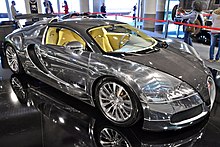
|
September 2007 | 5 units were made. The first Veyron to feature no paint, and instead use an exposed carbon fiber and aluminum finish.[31] | |
| Bugatti Veyron Fbg par Hermès[32] | 
|
March 2008 | €1.55 million, excluding taxes and transport[33] | Collaboration with French design house Hermès, featuring a bull calfskin interior. This model was limited to four units. A Veyron 16.4 Grand Sport was later produced in the same configuration. |
| Bugatti 16.4 Veyron Sang Noir[34] | 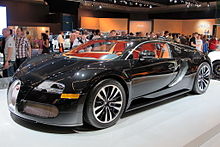
|
May 2008 | 12 units were made. | |
| Bugatti Veyron Bleu Centenaire[35] | 
|
March 2009 | 1 unit was made. | |
| Bugatti Veyron "Jean-Pierre Wimille"[36] | 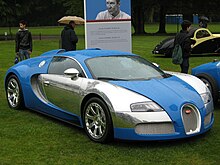
|
September 2009 | Named after French racing driver Jean-Pierre Wimille who was a factory driver for Bugatti in the 1930s. | |
| Bugatti Veyron "Achille Varzi" | September 2009 | Named after Italian racing driver Achille Varzi who raced for Bugatti in the early 1930s. | ||
| Bugatti Veyron "Malcolm Campbell" | September 2009 | Named after British racing driver Malcolm Campbell who raced for Bugatti in the late 1920s. | ||
| Bugatti Veyron "Hermann zu Leiningen" | 
|
September 2009 | Named after German racing driver Hermann zu Leiningen who raced for Bugatti in the early 1930s. |
Bugatti Veyron 16.4 Grand Sport (2009–2015)[edit]
The targa top version of the Bugatti Veyron EB 16.4, dubbed the Bugatti Veyron 16.4 Grand Sport, was unveiled at the 2008 Pebble Beach Concours d'Elegance.[37][38] It has extensive reinforcements to compensate for the lack of a standard roof[39] and small changes to the windshield and running lights. Two removable tops are included, the second a temporary arrangement fashioned after an umbrella. The top speed with the hardtop in place is the same as the standard coupé version, but with the roof removed is limited to 369 km/h (229 mph)—and to 130 km/h (81 mph) with the temporary soft roof. The Grand Sport edition was limited to 150 units, with the first 50 going exclusively to registered Bugatti customers. Production began in the second quarter of 2009.
Special editions[edit]
| Name | Picture | Release date | Release price | Notes |
|---|---|---|---|---|
| Bugatti Veyron 16.4 Grand Sport Sang Bleu[40] | 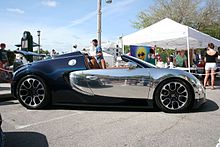
|
August 2009[41] | One off model featuring a two tone blue carbon fiber and polished aluminum exterior. | |
| Bugatti Veyron 16.4 Grand Sport L'Or Blanc[42] | 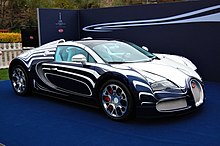
|
June 2011 | €1.65 million, excluding taxes and transport | Collaboration between Bugatti and the Royal Porcelain Factory in Berlin. Claimed to be the first car to feature real porcelain parts, with a thin porcelain layer coating the exterior, as well as porcelain inlays on the interior and on certain exterior pieces such as the fuel filler cap, badges, and wheel center caps. One made. |
| Bugatti Veyron 16.4 Grand Sport "Dubai Motor Show 2011" Special Edition[43] | 
|
November 2011 | €1.58 million, excluding taxes and transport | Introduced with a horizontal colour split with a bright yellow body framed in visible black carbon (including black-tinted wheels), seats in yellow-coloured leather upholstery with black stitching, middle console in black carbon, dashboard, steering wheel and gearshift made of black leather with yellow stitching.[44] The car was then shown again at the 2012 Qatar Motor Show. |
| Bugatti Veyron 16.4 Grand Sport "Dubai Motor Show 2011" Special Edition | November 2011 | €1.74 million, excluding taxes and transport | Presented in a two-tone horizontal colour split consisting of visible blue carbon, framed in polished, anodised aluminium. | |
| Bugatti Veyron 16.4 Grand Sport "Dubai Motor Show 2011" Special Edition | 
|
November 2011 | €1.74 million, excluding taxes and transport | Came in the newly developed green carbon fibre tone with polished aluminium. |
| Bugatti Veyron 16.4 Grand Sport Bernar Venet[45] | 
|
December 2012[46] | One off model painted by French conceptual artist Bernar Venet, with designs on the exterior and interior made up of technical equations used by Bugatti engineers during the making of the Veyron.[47] |


